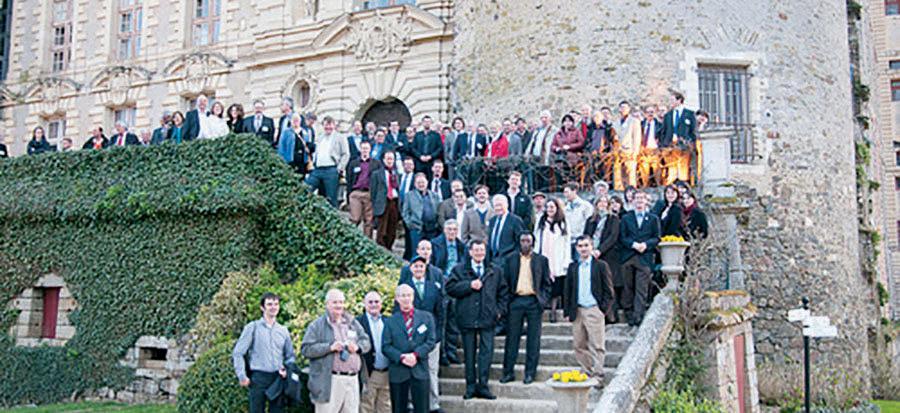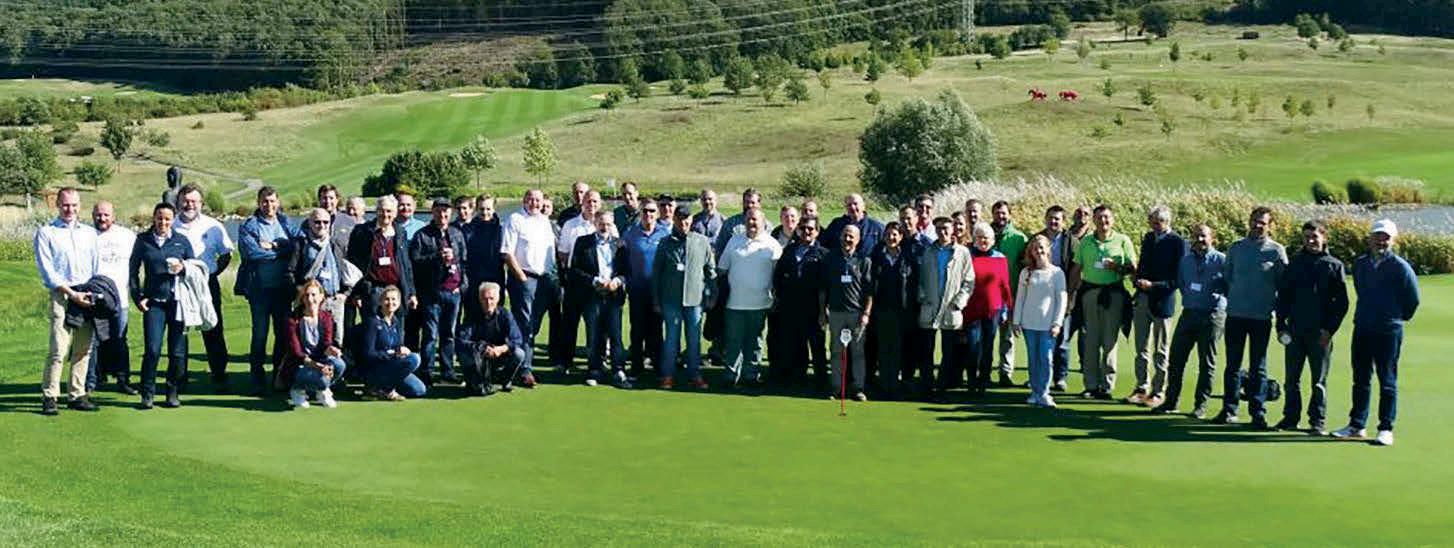
8 minute read
Association Updates—ETS and Turf Australia Activities
ASSOCIATION UPDATES

THE EUROPEAN TURFGRASS SOCIETY UPDATE
By Claudia de Bertoldi, PhD

The objectives of the European Turfgrass Society (ETS) include the spread of innovative applications and encouragement of a holistic view of turfgrass, particularly with respect to its influence on urban and environmental quality. This approach is significant as the founding members are representatives of a large industry that has global importance. We aim to: a) Provide a forum for scientists, consultants, companies, and practitioners to discuss technical issues related to the provision of turfgrass surfaces. b) Spread innovative applications for the benefit of the turfgrass industry, national and local government, and the European public. Encourage a systems-based approach to the study of turfgrass through multi-disciplinary groups working at different levels. c) ETS considers turfgrass knowledge in the broadest sense, including its use in sport and leisure, its role in improving urban quality, and its importance in the mitigation of environmental effects such as soil erosion. d) Develop a strong ethos to promote sustainable, low input systems and solutions based on the conscious use of non-renewable resources.
2022 European Turfgrass Society Field Days
The ETS is organizing Field Days in spring 2022 dedicated to members and all turfgrass specialists and professionals involved in the lawn and sports turf care and landscape. We will continue the successful experiences provided in previous years. It will be a great chance to spend quality time together and an excellent opportunity to meet in person after a long period of social isolation. (See photos of past ETS in person events.)
The 2022 Field Days will focus on practical experiences to convey and share technical aspects and challenges to attendees by visiting research sites and functional turf areas for a very informative and enjoyable time. We are hoping for large participation, and we will soon provide all necessary information on the ETS website (www.turfgrasssociety.eu).
This past spring, ETS organized a series of free webinars to offer useful and targeted communication to members and all turfgrass specialists interested. The main objective of these webinars was to explore the interest in environmental issues related to turfgrass management; bring together the industry, the academy, and many greenkeepers; and create a space for participants to ask questions and engage with speakers. Each webinar was conducted by two speakers and was followed by a panel discussion.
These webinars were held live on the dates noted with each one below. They were made available for viewing for several months afterward—at no charge—for a those that were not able to take part previously.

First Seminar—Sponsored by Syngenta— was held March 25, 2021
Topic: Understanding the role of bio-stimulants in turfgrass management under drought stress Speakers: Dr. Diego Gómez de Barreda Ferraz, an associate professor at the Plant Production Department of the Polytechnic University of Valencia (UPV), and MSc. Marcela Munoz, a leading turfgrass specialist qualified as an agronomist engineer from The Pontifical Catholic University of Chile.
The Second Seminar—Sponsored by COMPO Expert— was held March 30, 2021
Topic: Plant Nutrition, Biostimulants, and Biotic Stress Tolerance of Turf
Speakers: Dr. James Murphy, director of the Rutgers Center for Turfgrass Science and an extension specialist in Turfgrass Management at Rutgers University, and Dr. Chas Schmid, faculty research associate at Oregon State University.
The Third seminar—Sponsored by Turf Europe/GreenGO— was held April 13, 2021
Topic: Precision Turfgrass Management: technical advances to improve turf aesthetics, performance, and sustainability (golf, sports fields, and gardens) Speakers: Dr. Filippo Lulli addressed “Precision Turfgrass Management: tools and simple agroclimatic interpretation rules,” and MSc. Alessio Forconi addressed “The GreenGO ecosystem of sensors and software: Your Turfgrass Assistant”
The spring webinar series has seen a considerable number of participants (between 75 and 85 attendees) from different countries all over the world. The panel discussions were interactive with many questions and the recordings of the webinars have been watched several times after the events.
More ETS Webinars to Come
The spring series of webinars gave ETS the opportunity to communicate new experiences and maintain relationships with people involved online. It was an excellent opportunity to convey recent scientific results and new technologies for turfgrass management. The fact that all sectors related to turfgrass had been involved was in full compliance with the objectives of our Society. We discovered a great appreciation for this initiative, as demonstrated by the significant participation and it was an unexpected success. Given the long-term restrictions all over the world, it will probably be difficult to meet in person throughout 2021, but we wish to keep on providing knowledge and connections for the benefit of the turfgrass world. Thus, we have decided to propose a new "2021 European Turfgrass Society Webinar Series” for the coming autumn in preparation for Field Days in spring 2022. The format of the fall webinars is as follows: • The admission to webinars is NOT subject to a registration fee. • Each webinar has a dedicated theme. • Each webinar will have 2 academic/independent turf specialist/speaker presentations. Total time of each webinar: 1 hour and 30 minutes. • There will be a panel discussion after the presentations of 40 minutes with possibility of interactions with the speakers. The Autumn series of webinars, which will be held online, will focus on the following topics: • Sustainable Disease, Pest, and Weed Control - Natural/
Organic Products • Fertilization & Biostimulants - Advanced Stress
Management with Biostimulants • Water scarcity and irrigation - Sustainable Water
Management • Turf Cultivars/Breeding • Mechanical Practices Advantages • Wear Tolerance (species and cultivar selection, plant growth regulators, fertilization) • Specific webinar to greenkeepers or groundsmen (topic to be determined) Information on the dates and times, and the instructions for participating in the Autumn "2021 European Turfgrass Society Webinar Series” will be available once the schedule is finalized. For that information and other updates, please visit the ETS website (www.turfgrasssociety.eu) or contact the Organizing Committee via e-mail: etsoffice@turfgrasssociety.eu.
Dr. Claudia de Bertoldi is the European Turfgrass Society (ETS) secretary and communications manager. All photos courtesy of the European Turfgrass Society.

ASSOCIATION UPDATES

TURF AUSTRALIA INTRODUCES VIDEO SERIES HIGHLIGHTING THE BENEFITS OF NATURAL GRASS
By Jenny Zardo
Turf Australia has developed a series of videos which talk to the far-reaching benefits of living turfgrass. Whether it be the way natural grass cools our cities, reduces bushfire risk, or just provides a real connection with nature—a series of interviews with turf growers and health experts help articulate the true value of turfgrass. The videos are aimed at anyone who may be interested in landscaping, developing, town planning, architecture and design, or simply do-it-yourself (DIY) home improvement. The videos are available here: 3-minute video: https://youtu.be/gcOgtlZSrqs 60 second video: https://youtu.be/wxKE2e-m7WA Please feel free to share these videos with your networks, on your website, via regular newsletters, or through social media. Turf Australia has already shared the video on our social media: https://fb.watch/6oT0mjMjaF/. Also, feel free to share directly from that link.
Suggested Social Media Copy
We have taken the liberty of drafting a suggested social media post, which you are of course welcome to amend as you see fit. Natural grass is living air conditioning, cooling our cities. Natural grass filters and cleans our water, reduces wildfire risk, raises the value of our homes, and promotes biodiversity. Find out more about what makes natural grass the best choice for our planet, our communities, and our families. #KeepItReal
A Bit of Turf Australia Background
Turf Australia is the representative body of the Turfgrass Industry comprised of levy-paying turf producers and individual members Australia wide. Our Mission is to support our members and lead a sustainable natural turfgrass industry. Through communication and advocacy, we ensure that turfgrass and our industry are valued by the Australian community, regulators, and special interest groups. Through strong arguments based on scientific research, we demonstrate that turfgrass has an important role to play in managing the impacts of climate change.
Production Size and Value
Australia’s Turf production industry includes approximately 230 turf production businesses throughout the country, producing an estimated $280 million worth of turfgrass (farm gate value) annually (2019/20 statistics). Over 38 million square meters of turf (9390 acres) was produced during 2019/20 with turf production in Queensland and Northern Territory representing 43 percent of the total while New South Wales and Australian Capital Territory represents 30 percent, Victoria and Tasmania 14 percent, Western Australia six percent and South Australia seven percent. Click on the link that follows for the ten-page Snapshot report of the Australian Turf Industry for 2019/20. https://www.turfaustralia.com.au/public/85/files/2020_ Grower_Snapshot_Report_%20FINAL.pdf
Research and Development and Marketing Key to Strategic Plan
In recent times, Australian growers have continued to seek and embrace new technologies to make their businesses more efficient and viable. However, the industry has also faced challenges emanating from drought and subsequent water shortages. Other problems include declining industry profitability, increasing production costs and water supply concerns; product variability and consumer sustainability concerns; increasing environmental concerns; urban encroachment; a trend to smaller housing plots, gardens and lawn; and a public perception that turf is a high water and fertilizer use product. In 2006, Australian Turf Producers elected to support the introduction of a horticultural products levy for Research and Development and Marketing and a Turfgrass industry strategic plan was developed to guide how the levy funds can be best used to benefit the industry. The funding is managed by Horticulture Innovation on behalf of the Australian Government.
The industry strategic investment plans are reviewed annually and, approximately every four to five years, a new strategic investment plan is developed in consultation with turfgrass growers and Turf Australia.
Looking Forward
Turf Australia will have some animated style videos that we will release over the coming months focusing on similar messages— environmental and health benefits of natural turf. We will be happy to share those as well once they are completed.











